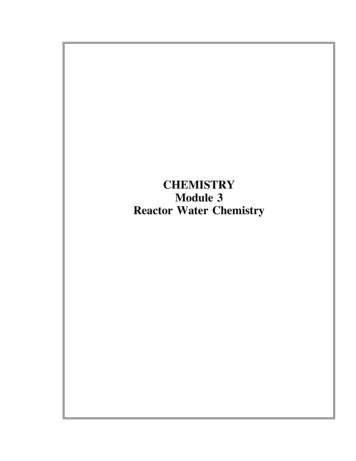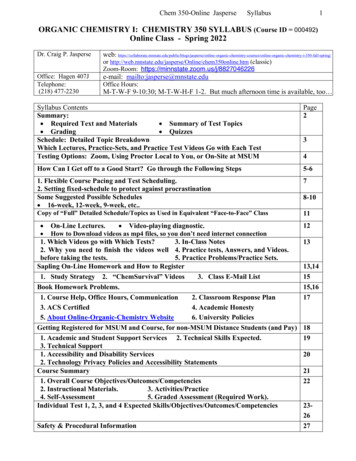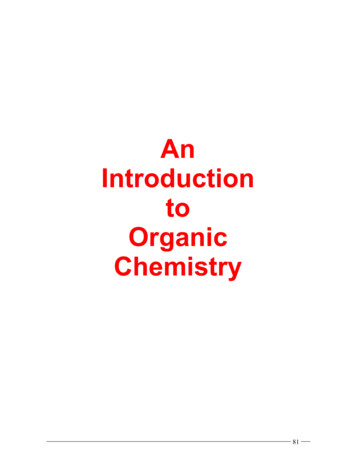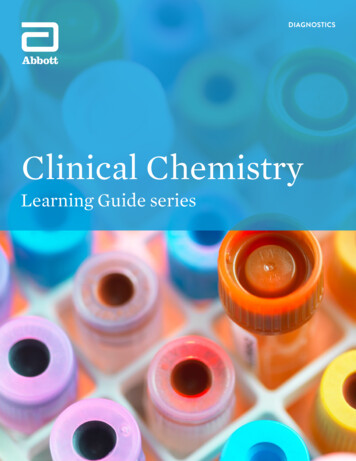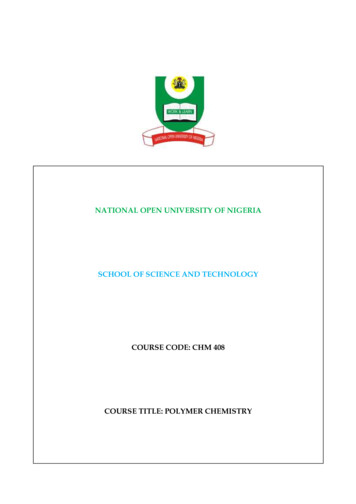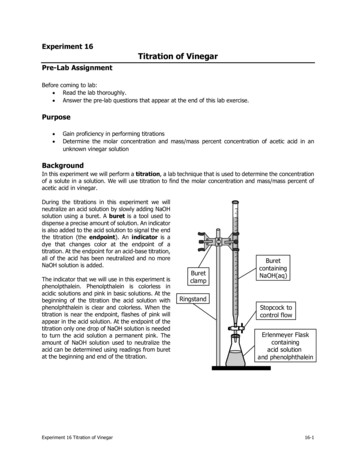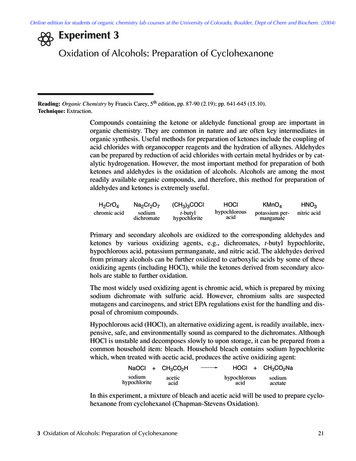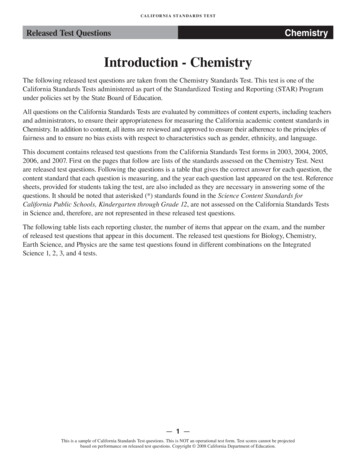
Transcription
CA L I F O R N I A S TA N DA R D S T E S TChemistryReleased Test QuestionsIntroduction - ChemistryThe following released test questions are taken from the Chemistry Standards Test. This test is one of theCalifornia Standards Tests administered as part of the Standardized Testing and Reporting (STAR) Programunder policies set by the State Board of Education.All questions on the California Standards Tests are evaluated by committees of content experts, including teachersand administrators, to ensure their appropriateness for measuring the California academic content standards inChemistry. In addition to content, all items are reviewed and approved to ensure their adherence to the principles offairness and to ensure no bias exists with respect to characteristics such as gender, ethnicity, and language.This document contains released test questions from the California Standards Test forms in 2003, 2004, 2005,2006, and 2007. First on the pages that follow are lists of the standards assessed on the Chemistry Test. Nextare released test questions. Following the questions is a table that gives the correct answer for each question, thecontent standard that each question is measuring, and the year each question last appeared on the test. Referencesheets, provided for students taking the test, are also included as they are necessary in answering some of thequestions. It should be noted that asterisked (*) standards found in the Science Content Standards forCalifornia Public Schools, Kindergarten through Grade 12, are not assessed on the California Standards Testsin Science and, therefore, are not represented in these released test questions.The following table lists each reporting cluster, the number of items that appear on the exam, and the numberof released test questions that appear in this document. The released test questions for Biology, Chemistry,Earth Science, and Physics are the same test questions found in different combinations on the IntegratedScience 1, 2, 3, and 4 tests.— 1 —This is a sample of California Standards Test questions. This is NOT an operational test form. Test scores cannot be projectedbased on performance on released test questions. Copyright 2008 California Department of Education.
CA L I F O R N I A S TA N DA R D S T E S TChemistryReleased Test QuestionsNUMBER OFQUESTIONSON EXAMNUMBER OFRELEASEDTEST QUESTIONS67Atomic and Molecular StructureAtomic and Molecular Structure (Standards: CH1. a-e)Nuclear Processes (Standards: CH11. a-e)811Chemical Bonds, BiochemistryChemical Bonds (Standards: CH2. a-e)Organic Chemistry and Biochemistry (Standards: CH10. a-c)911Kinetics, ThermodynamicsGases and Their Properties (Standards: CH4. a-f)Solutions (Standards: CH6. a-d)Chemical Thermodynamics (Standards: CH7. a-d)1418Chemical ReactionsAcids and Bases (Standards: CH5. a-d)Reaction Rates (Standards: CH8. a-c)Chemical Equilibrium (Standards: CH9. a-b)1317Conservation of Matter and Stoichiometry(Standards: CH3. a-e)1011TOTAL6075REPORTING CLUSTERInvestigation and Experimentation(Standards: CHIE1. a-n)In selecting test questions for release, three criteria are used: (1) the questions adequately cover a selection of theacademic content standards assessed on the Chemistry Test; (2) the questions demonstrate a range of difficulty;and (3) the questions present a variety of ways standards can be assessed. These released test questions do notreflect all of the ways the standards may be assessed. Released test questions will not appear on future tests.For more information about the California Standards Tests, visit the California Department of Education’sWeb site at http://www.cde.ca.gov/ta/tg/sr/resources.asp.— 2 —This is a sample of California Standards Test questions. This is NOT an operational test form. Test scores cannot be projectedbased on performance on released test questions. Copyright 2008 California Department of Education.
CA L I F O R N I A S TA N DA R D S T E S TChemistryReleased Test QuestionsTHE INVESTIGATION AND EXPERIMENTATION REPORTING CLUSTERThe following 14 California content standards are included in the Investigation and Experimentation reportingcluster and are represented in this booklet by seven test questions. These questions represent only some ways inwhich these standards may be assessed on the California Chemistry Standards Test.CALIFORNIA CONTENT STANDARDS IN THIS REPORTING CLUSTERInvestigation and ExperimentationCHIE1.Scientific progress is made by asking meaningful questions and conductingcareful investigations. As a basis for understanding this concept and addressingthe content in the other five reporting clusters, students should develop their ownquestions and perform investigations. Students will:CHIE1. a.Select and use appropriate tools and technology (such as computer-linked probes,spreadsheets, and graphing calculators) to perform tests, collect data, analyzerelationships, and display data.CHIE1. b.Identify and communicate sources of unavoidable experimental error.CHIE1. c.Identify possible reasons for inconsistent results, such as sources of error oruncontrolled conditions.CHIE1. d.Formulate explanations by using logic and evidence.CHIE1. e.Solve scientific problems by using quadratic equations and simple trigonometric,exponential, and logarithmic functions.CHIE1. f.Distinguish between hypothesis and theory as scientific terms.CHIE1. g.Recognize the usefulness and limitations of models and theories as scientificrepresentations of reality.CHIE1. h.Read and interpret topographic and geologic maps.CHIE1. i.Analyze the locations, sequences, or time intervals that are characteristic of naturalphenomena (e.g., relative ages of rocks, locations of planets over time, and successionof species in an ecosystem).CHIE1. j.Recognize the issues of statistical variability and the need for controlled tests.CHIE1. k.Recognize the cumulative nature of scientific evidence.CHIE1. l.Analyze situations and solve problems that require combining and applying conceptsfrom more than one area of science.CHIE1. m.Investigate a science-based societal issue by researching the literature, analyzing data,and communicating the findings. Examples of issues include irradiation of food, cloningof animals by somatic cell nuclear transfer, choice of energy sources, and land and wateruse decisions in California.CHIE1. n.Know that when an observation does not agree with an accepted scientific theory, theobservation is sometimes mistaken or fraudulent (e.g., the Piltdown Man fossil orunidentified flying objects) and that the theory is sometimes wrong (e.g., the Ptolemaicmodel of the movement of the Sun, Moon, and planets).— 3 —This is a sample of California Standards Test questions. This is NOT an operational test form. Test scores cannot be projectedbased on performance on released test questions. Copyright 2008 California Department of Education.
CA L I F O R N I A S TA N DA R D S T E S TChemistryReleased Test QuestionsTHE ATOMIC AND MOLECULAR STRUCTURE REPORTING CLUSTERThe following 10 California content standards are included in the Atomic and Molecular Structure reportingcluster and are represented in this booklet by 11 test questions. These questions represent only some ways inwhich these standards may be assessed on the California Chemistry Standards Test.CALIFORNIA CONTENT STANDARDS IN THIS REPORTING CLUSTERAtomic and Molecular StructureCH1.The periodic table displays the elements in increasing atomic number and showshow periodicity of the physical and chemical properties of the elements relates toatomic structure. As a basis for understanding this concept:CH1. a.Students know how to relate the position of an element in the periodic table to its atomicnumber and atomic mass.CH1. b.Students know how to use the periodic table to identify metals, semimetals, non-metals,and halogens.CH1. c.Students know how to use the periodic table to identify alkali metals, alkaline earthmetals and transition metals, trends in ionization energy, electronegativity, and therelative sizes of ions and atoms.CH1. d.Students know how to use the periodic table to determine the number of electronsavailable for bonding.CH1. e.Students know the nucleus of the atom is much smaller than the atom yet contains mostof its mass.Nuclear ProcessesCH11.Nuclear processes are those in which an atomic nucleus changes, includingradioactive decay of naturally occurring and human-made isotopes, nuclearfission, and nuclear fusion. As a basis for understanding this concept:CH11. a.Students know protons and neutrons in the nucleus are held together by nuclear forcesthat overcome the electromagnetic repulsion between the protons.CH11. b.Students know the energy release per gram of material is much larger in nuclear fusionor fission reactions than in chemical reactions. The change in mass (calculated byE mc 2) is small but significant in nuclear reactions.CH11. c.Students know some naturally occurring isotopes of elements are radioactive, as areisotopes formed in nuclear reactions.CH11. d.Students know the three most common forms of radioactive decay (alpha, beta, andgamma) and know how the nucleus changes in each type of decay.CH11. e.Students know alpha, beta, and gamma radiation produce different amounts and kinds ofdamage in matter and have different penetrations.— 4 —This is a sample of California Standards Test questions. This is NOT an operational test form. Test scores cannot be projectedbased on performance on released test questions. Copyright 2008 California Department of Education.
CA L I F O R N I A S TA N DA R D S T E S TChemistryReleased Test QuestionsTHE CHEMICAL BONDS, BIOCHEMISTRY REPORTING CLUSTERThe following eight California content standards are included in the Chemical Bonds, Biochemistry reportingcluster and are represented in this booklet by 11 test questions. These questions represent only some ways inwhich these standards may be assessed on the California Chemistry Standards Test.CALIFORNIA CONTENT STANDARDS IN THIS REPORTING CLUSTERChemical BondsCH2.Biological, chemical, and physical properties of matter result from the ability ofatoms to form bonds from electrostatic forces between electrons and protons andbetween atoms and molecules. As a basis for understanding this concept:CH2. a.Students know atoms combine to form molecules by sharing electrons to form covalentor metallic bonds or by exchanging electrons to form ionic bonds.CH2. b.Students know chemical bonds between atoms in molecules such as H2, CH4, NH3,H2CCH2, N2, Cl2 and many large biological molecules are covalent.CH2. c.Students know salt crystals, such as NaCl, are repeating patterns of positive andnegative ions held together by electrostatic attraction.CH2. d.Students know the atoms and molecules in liquids move in a random pattern relative toone another because the intermolecular forces are too weak to hold the atoms ormolecules in a solid form.CH2. e.Students know how to draw Lewis dot structures.Organic Chemistry and BiochemistryCH10.The bonding characteristics of carbon allow the formation of many differentorganic molecules of varied sizes, shapes, and chemical properties and providethe biochemical basis of life. As a basis for understanding this concept:CH10. a.Students know large molecules (polymers), such as proteins, nucleic acids, and starch,are formed by repetitive combinations of simple subunits.CH10. b.Students know the bonding characteristics of carbon that result in the formation of alarge variety of structures ranging from simple hydrocarbons to complex polymers andbiological molecules.CH10. c.Students know amino acids are the building blocks of proteins.— 5 —This is a sample of California Standards Test questions. This is NOT an operational test form. Test scores cannot be projectedbased on performance on released test questions. Copyright 2008 California Department of Education.
CA L I F O R N I A S TA N DA R D S T E S TChemistryReleased Test QuestionsTHE KINETICS, THERMODYNAMICS REPORTING CLUSTERThe following 14 California content standards are included in the Kinetics, Thermodynamics reporting clusterand are represented in this booklet by 18 test questions. These questions represent only some ways in whichthese standards may be assessed on the California Chemistry Standards Test.CALIFORNIA CONTENT STANDARDS IN THIS REPORTING CLUSTERGases and Their PropertiesCH4.The kinetic molecular theory describes the motion of atoms and molecules andexplains the properties of gases. As a basis for understanding this concept:CH4. a.Students know the random motion of molecules and their collisions with a surface createthe observable pressure on that surface.CH4. b.Students know the random motion of molecules explains the diffusion of gases.CH4. c.Students know how to apply the gas laws to relations between the pressure,temperature, and volume of any amount of an ideal gas or any mixture of ideal gases.CH4. d.Students know the values and meanings of standard temperature and pressure (STP).CH4. e.Students know how to convert between the Celsius and Kelvin temperature scales.CH4. f.Students know there is no temperature lower than 0 Kelvin.SolutionsCH6.Solutions are homogenous mixtures of two or more substances. As a basis forunderstanding this concept:CH6. a.Students know the definitions of solute and solvent.CH6. b.Students know how to describe the dissolving process at the molecular level by usingthe concept of random molecular motion.CH6. c.Students know temperature, pressure, and surface area affect the dissolving process.CH6. d.Students know how to calculate the concentration of a solute in terms of grams per liter,molarity, parts per million, and percent composition.Chemical ThermodynamicsCH7.Energy is exchanged or transformed in all chemical reactions and physicalchanges of matter. As a basis for understanding this concept:CH7. a.Students know how to describe temperature and heat flow in terms of the motion ofmolecules (or atoms).CH7. b.Students
content standard that each question is measuring, and the year each question last appeared on the test. Reference sheets, provided for students taking the test, are also included as they are necessary in answering some of the questions. It should be noted that asterisked (*) standards found in the Science Content Standards for California Public Schools, Kindergarten through Grade 12, are not .

